5 Major Ports in Portugal
Portugal lies on the Iberian Peninsula in Southwestern Europe and faces the Atlantic Ocean on its western and southern borders. It is a developed nation with a prosperous economy.
The shipping and marine transportation sector are fairly advanced due to increased foreign investments, technological developments and government policies.
Portugal has 40 seaports and riverports that are highly developed facilities, at par with global maritime standards due to constant infrastructural development and modernization projects.
In this article, let us look at the five major ports of Portugal, their terminals and other facilities and services.
These ports are the biggest contributors to the country’s GDP and handle more than half of the nation’s international trade.
Port of Lisbon
Lisbon port is the main seaport of Portugal. Situated on the banks of river Tagus, near its outlet to the Atlantic Ocean, the port handles most of the country’s export-import trade. The city of Lisbon holds administrative and commercial significance, and hence Lisbon port is an essential contributor to the city’s economy, serving its manufacturing, industrial and tourism sectors.
Lisbon port is the busiest port compared to other Portuguese ports, visited by more than 3500 vessels every year and handling 13,200,000 tonnes of cargo and 555,000 TEU. It mostly deals with agricultural foodstuff and containerized cargo. However, it is not just a commercial port facility but a popular tourist destination that attracts recreational boaters and yachters.
Lisbon is considered an ancient port city used as a trading post by the Phoenicians. During European colonial expansion in the 18th and 19th centuries, imperialist powers like Britsh, Portuguese and Dutch longed to colonize it, as it enjoyed a privileged geographical location.
It is located amidst the world’s major oceanic trade routes, connecting the Mediterranean region with Northern and Central Europe and enabling maritime trade among the continents of the far east, Africa, Europe and America.
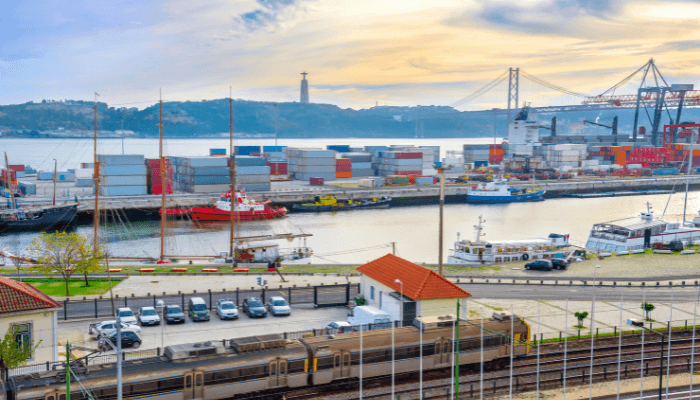
Today, it is one of the world’s most efficient port facilities that continue to attract investors and tourists alike. Numerous multinational corporations and shipping companies have based their headquarters in Lisbon. Lisbon port boasts world-class services focusing on customer satisfaction and increasing the port’s productivity.
The port of Lisbon covers more than 32,000 hectares, and over 16,000 m of berthage is available. It is spread over the North and the South banks; the former has numerous berths with a total length of 13,000 m with varying depths of 4 to 13 m. The berths on the Southern bank span 3000 m with a depth of 3 to 17 m.
All diverse cargo, including conventional goods, bulk, and containers, are handled on the North Bank. Apart from handling cargo, the North Bank also contains three passenger or cruise ship terminals, such as the Alcantra terminal, which possess the best safety equipment.
Recreational boating is a favourite activity at the port, which offers excellent conditions for all kinds of boaters throughout the year. Hence, the port manages four docks with a handling capacity of around 1100 boats and provides essential services to boaters. Due to all these factors, Lisbon port sees more than 400,000 tourists annually.
The South Bank comprises specialized facilities for handling solid and liquid bulk cargo such as chemicals, fertilizers, ores, and bunkering. It also has Lisnave shipyards, a joint venture of Portuguese and other international shipping corporations.
Port of Aveiro
Port of Aveiro lies on the western coastline of Portugal on the bank of the Aveiro river. It is a sheltered river port that deals with general cargo exports, paper pulp, liquid chemicals, fish and imports of grains, metal products, and cement. It handles about 3.5 million tonnes of cargo annually and is visited by more than 1000 vessels annually.
The port authority is Administracao do Porto de Aveiro (APA SA), which was formed in 1998 and is responsible for the operation, management and developmental projects of the Aveiro port.
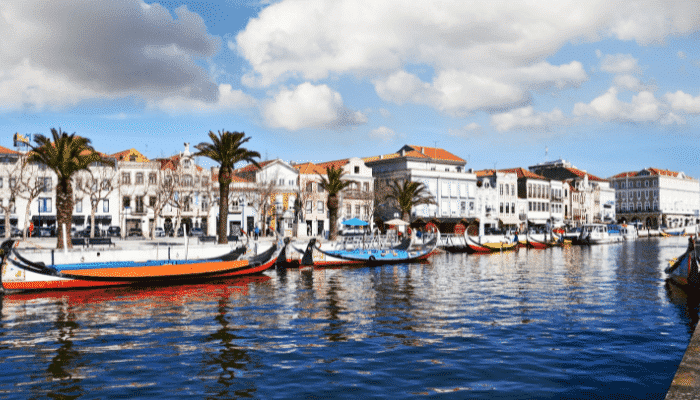
The port is divided into five specific zones: the North terminal, Chemical handling facility, offshore fishing sector, South terminal and the Coastal fishing zone. Thus, it is a multipurpose port crucial for the Portuguese economy as it serves numerous industries in its hinterlands, such as ceramics, wine-making units, chemical plants, wood and its derivatives, including agricultural and manufacturing.
North Terminal
Port Aveiro’s North Terminal comprises a 900 m long dock spanning 328 m. It also contains eight warehouses, two dedicated to storing cement and bagged goods. This facility mainly deals with general cargo and solid bulk like cement, cereal, paper, metal, wood and clay.
The Roll-on/Roll-off Terminal includes a 450 m long pier with a depth of 11 m and covers 130,000 sq m.
South Terminal
Containing a 400 m long wharf with a depth of 7 m covering roughly 47,000 sq m, the Socarpor Company operates this facility. It has a sheltered storage space and three warehouses, two dedicated to keeping cement and bulk cargo. This terminal handles cement, fish, sea salt, cereal, Kaolin, clay, and paper.
Liquid Bulk Terminal
The chemical handling region of the port includes facilities leased to some private shipping companies that handle shipments of vinyl chloride, fuels, anilines, MDI, methanol, and other chemicals.
Bulk Cargo Terminal
It is a specialized facility dealing with agro-alimentary and non-alimentary goods. This terminal has a 750 m long wharf with a depth of 12 m, spanning 150 thousand sq m.
Port of Leixoes
Leixoes port is one of the essential ports in Portugal. Situated on the river Douro on the western coast of the Iberian peninsula, it serves the country’s northern region by handling containerized cargo, conventional cargo, solid and liquid bulk and ro-ro and passenger vessels. It is a multipurpose port facility that handles more than 20% of Portuguese international trade.
More than 2500 vessels frequent the port annually while its cargo throughput is around 15,650,000 tonnes, and it handles 450,000 TEU of containerized goods and more than 25,000 passengers. It can also accommodate the biggest carrier ships weighing more than 100,000 tonnes.
The port comprises three quays for handling conventional cargo, which deals with shipments of cotton, cork, timber, iron and steel, granite, metal, vehicles and chassis, cereals, machinery, transformers and wind turbines. These three docks have the latest port equipment and a storage space spanning more than 50,000 sq m.
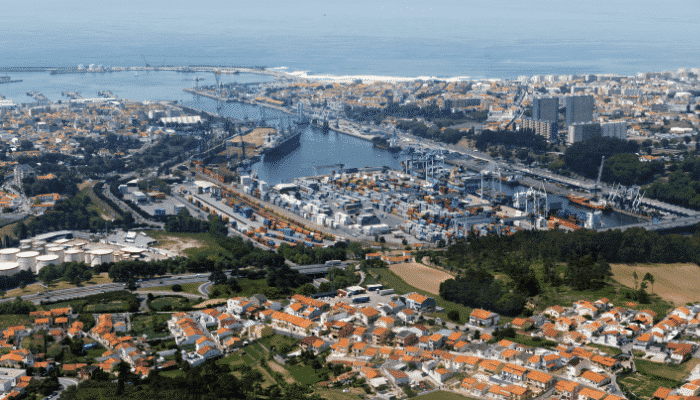
Container Terminals
Leixoes port has a north and a south container handling facility that became operational in 1999 and expanded considerably. The Northern terminal spans six hectares and has a 360 m long quay. It has an annual handling capacity of 250,000 TEUs and a storage capacity of 4000 TEUs.The Southern Terminal comprises a 540-meter long quay with alongside depth of 12 meters. Spanning 16 hectares, it handles 350 thousand TEUs annually and stores 15 thousand TEUs.
Agri-bulk Terminal
This facility comprises a 400 m quay equipped with three cranes and a pollution control system. It has a 22,000 sq m storage space, two warehouses and two silo tanks with a storage capacity of 120,000 tonnes.
Liquid Bulk Terminal
This facility is dedicated to petroleum and its derivatives, however. Numerous berths, such as South Mole, handle liquid fuels, liquefied petroleum gas, asphalt, and molasses.
Oil Terminal
It is 700 m long, constructed 15 m above sea level, and connected to Petrogal Refinery through a pipeline. The oil terminal contains three piers that handle crude oil, refined oil, liquified gases and aromatic goods. The piers can accommodate vessels weighing around 100,000 DWT.
The Roll-on/Roll-off Terminal deals with weekly vehicles and heavy equipment shipments and incorporates a storage area for 100 trailers. The Passenger Terminal of the port covers 840 square meters. It has a 300 m long dock that can accommodate vessels 205 m long with an 8 m draft.
Port of Setubal
Setubal port lies on the estuary of the Sado river on the Atlantic coast of Portugal, some distance from Lisbon. Setubal is Portugal’s main port facility for handling ro-ro vessels, followed by containerized goods, breakbulk and bulk cargo. It also offers shipbuilding and ship repair facilities.
The port also serves the region’s fishing industry, which has a naturally well-sheltered harbour with a deep and safe anchorage. It handles about 6,100,000 tonnes of cargo every year and around 20,000 TEUs. More than 1500 ships visit the port annually. The main cargo dealt at this port includes roll-on/roll-off cargo, container goods, cement, clinker, metal, copper and zinc concentrate, oil, gasoline etc.
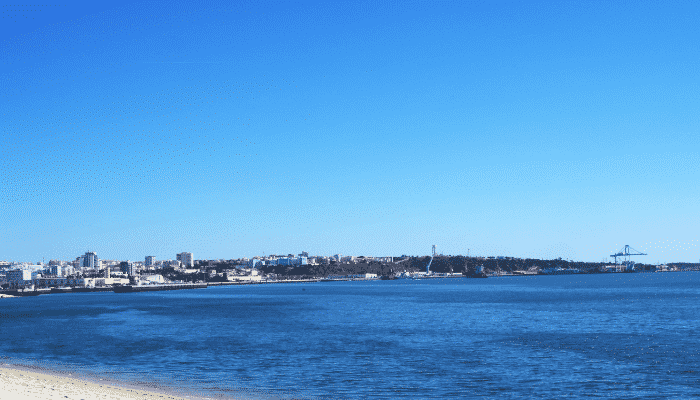
Multi-use Terminal Zone 1
This facility handles roll-on/roll-off, solid bulk, and containers on its 864 m long pier with a depth of 9.5 m. It also contains 2.1 thousand sq m of paved storage space.
Multi-use Terminal Zone 2
Comprising a 725 m long wharf, this terminal has a 50-ton capacity gantry crane and a post-Panamax crane with 1.6 thousand square meters of covered storage.
Terminal Portuario
This facility handles solid and liquid bulk and can accommodate ships with a 10.5 m draft. The terminal has three berths and a storage space spanning 25,000 sq m.
Private terminals
Setubal port has numerous terminals dedicated to private use by shipping companies. One such is the Terminal Secil, used by companies transporting cement, clinker and coal. This terminal has 60,000 sq m of storage space. The Terminal da Uralada is dedicated to liquid bulk only, such as alimentary oil and molasses and can accommodate huge ships weighing more than 50,000 DWT. Terminal Tanquisado handles combustible liquids, and the Teporset Terminal specializes in clinker and cement.
The port’s recreational dock of Fontainhas provides a mooring facility for about 150 small ships and boats. It also offers fresh water and recreational links along with sanitary facilities. The Lisnave Estaleiros Navais SA facility repairs ships and offshore platforms. It comprises six docks that can accommodate many vessels at once.
Port of Sines
Sines port lies on the western coast of Portugal, north of Sines bay and is a deepwater port that can receive the biggest ships. It has five terminal facilities for handling oil, petrochemicals, LNG, multipurpose, general cargo and containers. The port also includes a fishing harbour and a leisure marina. Breakwaters protect all terminals.
The major imports handled at the port are crude oil, coal, LNG and naphtha, while the main export commodities are refined oil and petrochemical products. The port is visited by more than 1400 vessels every year and handles 27,200,000 tonnes of cargo, including 230,000TEU.
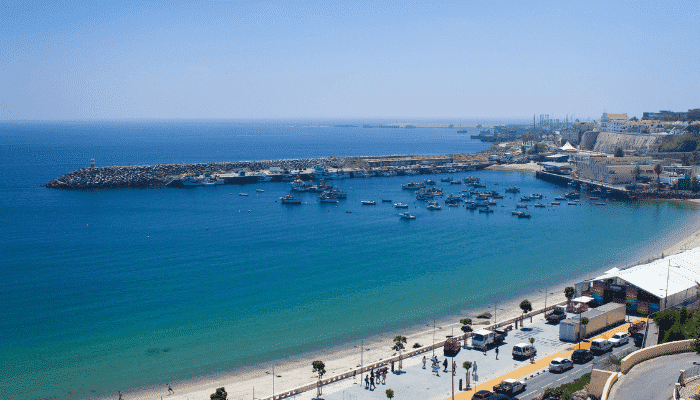
The Liquid Bulk Terminal has six docks and can receive vessels weighing 300,000 tonnes. The Petrochemical facility comprises two wharves to accommodate ships carrying Propylene, Ethylene, Butadiene, ETBE, Ethanol, MTBE, Aromatic Compounds, and Methanol. The multipurpose terminal handles general cargo and can accommodate vessels weighing up to 200,000t DWT. The port also has a Natural gas terminal with a dock capable of handling tankers up to 220,000 m3.
The port also has a container terminal that spans 42 hectares and has an annual cargo handling capacity of 2.4 million TEUs. This terminal is being expanded by implementing a port development project that would increase the port’s storage area to 60 hectares and its annual handling capacity to 4 million TEUs.
Portugal Ports Map
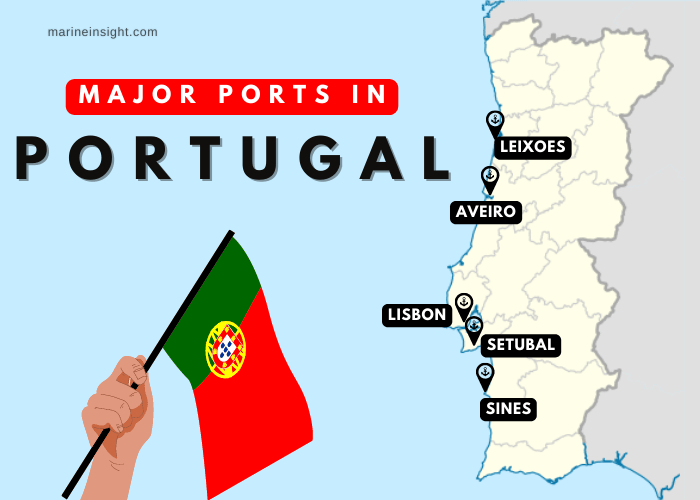
Frequently Asked Questions
1. Where do cruise ships dock in Lisbon?
Cruise ships dock at several piers such as the Santa Apolonia, Santa Apolonia Jusante, Jardim Do Tabaco, Alcantara and da Rocha. Where a cruise ship would berth depends on the vessel size and the schedule of the port authority. However, the first three docking berths are close to the city centre.
2. What is Aveiro known for?
Aveiro is associated with its vast canal network, which is part of its great history and the expansion of its port facilities. One can take a trip on these waterways in colourful traditional boats.
3. What is the importance of the Setubal port?
Setubal is the main port of Portugal for handling RORO vessels, followed by containerised goods, break bulk and general cargo. It is located in the industrial region and is close to a broad consumer market.
4. How many terminals are in Lexioes Port?
Lexioes port lies on the western coast of the Iberian peninsula. It has three quays for handling conventional cargo, two container terminals, an oil terminal, an agri-bulk terminal and a liquid bulk terminal.
5. What does port Sines specialise in?
Port Sines lies on the western coast of Portugal and specialises in handling refined oil and petrochemical products. Its liquid bulk terminal has six docks that can receive ships weighing up to 300,000 tonnes.
You might also like to read:
- 5 Major Ports in Peru
- 3 Major Ports of Angola
- 5 Major Ports In Switzerland
- 10 Major Ports in Romania
- 3 Major Ports of El Salvador
Disclaimer :
The information contained in this website is for general information purposes only. While we endeavour to keep the information up to date and correct, we make no representations or warranties of any kind, express or implied, about the completeness, accuracy, reliability, suitability or availability with respect to the website or the information, products, services, or related graphics contained on the website for any purpose. Any reliance you place on such information is therefore strictly at your own risk.
In no event will we be liable for any loss or damage including without limitation, indirect or consequential loss or damage, or any loss or damage whatsoever arising from loss of data or profits arising out of, or in connection with, the use of this website.
Do you have info to share with us ? Suggest a correction
Disclaimer :
The information contained in this website is for general information purposes only. While we endeavour to keep the information up to date and correct, we make no representations or warranties of any kind, express or implied, about the completeness, accuracy, reliability, suitability or availability with respect to the website or the information, products, services, or related graphics contained on the website for any purpose. Any reliance you place on such information is therefore strictly at your own risk.
In no event will we be liable for any loss or damage including without limitation, indirect or consequential loss or damage, or any loss or damage whatsoever arising from loss of data or profits arising out of, or in connection with, the use of this website.
Latest Maritime Knowledge Articles You Would Like:
Subscribe To Our Newsletters
By subscribing, you agree to our Privacy Policy and may receive occasional deal communications; you can unsubscribe anytime.















